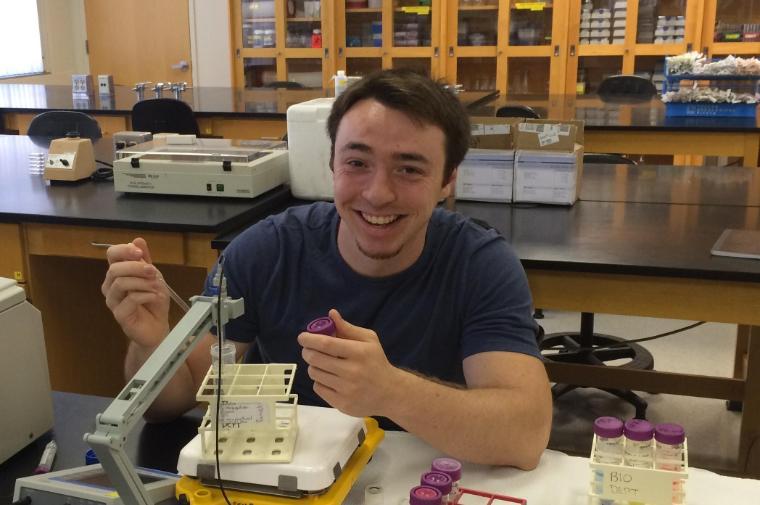
Research with a Side of Competition
A fascination for solving the puzzle of how to get other biological systems to harness biological concentration gradients, as electric eels do, to generate electricity has kept bioengineering senior Conary Meyer busy for years. "Using algae as a model photosynthetic system, I've been working on how to trigger unidirectional ionic flux through the cell to create electrical current from sunlight in a completely biological system. I came up with an idea for a bio-organic solar cell about four years ago and have been developing and testing different versions; I'm on my 23rd attempt now," he said. Recipient of an Honors Program Hayes Fellowship, Meyer receives funding and lab space to perform his research independently, which he does when he's not occupied with a smorgasbord of other activities. He has a campus job as a community facilitator, is a private tutor and TA for the physics department, was on the SCU boxing team before a torn ACL and meniscus sidelined him … oh, and he also enjoys painting, working out, and is learning to play the guitar. Sleep much?
And yet, with all this going on, he added one more thing to his plate, stepping up as leader of SCU's team participating in the International Genetically Engineered Machine (iGEM) competition, the premier contest for synthetic biology. In 2014, SCU's Joseph Ayar and Campbell Yore were the first law students to ever participate in the iGEM competition. They were back on board for the 2015 event, joining Meyer and fellow bioengineers Matt Kubit and Carlos Medina, along with Alex Codik (biochemistry), and Nicole Mattson and Vikrum Jain (biology). "One of the goals of the contest is to produce scientists who think outside the lab, who consider the societal and ethical implications of their work. Having the law students on the team gives a unique perspective, and of course as Santa Clara students, we are all accustomed to considering the ethical ramifications of our work," said Meyer.
Their project focuses on improving bioreactor technology. "In current bioreactors, especially fermenters, there is a serious problem with acid buildup inside the culture. As the cells grow and multiply they produce this organic acid which, if left unchecked, will kill the cells and end the culture. We aim to create an acid defense system that can be implemented in any organism with a simple genetic modification so that they can be used in these continuous cultures without having to neutralize the acid. Our loftier goal is that by making cells less sensitive to acid, we might be able to trick the cells into reaching higher cell concentrations which would increase protein yields, making more product, boosting profit," said Meyer.
In summer, all the teams received a kit of biological materials from the Registry of Standard Biological Parts, from which they could build new parts or find novel ways for using the standardized pieces called BioBricks. After pondering numerous ideas, team SCU iGEM landed on the use of the gene found in E. coli, a bacterium known to withstand highly acidic environments. Their idea: create a sort of barbed wire effect at the edge of the microorganisms' cells to keep acid out. "E. coli changes its membrane permeability by making a cyclopropane group off of the phospholipid tails at the same carbon site all around the bottom and top layer of the cell membrane. Once we found that, we knew we had it!" Meyer said.
"From there, we just had to figure out how to test and build the system. Our system is designed to cause the addition of a step in the fatty acid biosynthetic pathway that causes the insertion of an extra carbon to their chains which will cause an overhaul of the membrane with these modified phospholipids. This change to the membrane would then make it more challenging for acid to diffuse across the membrane, resulting in the acid resistant phenotype that we were striving for."
At the iGEM competition, teams from 234 universities, representing 39 countries, presented their genetically engineered machines--including academic findings, community service and entrepreneurship aspects. Santa Clara's team, advised by Bioengineering Associate Professor Zhiwen (Jonathan) Zhang and the Business School's Bill Mains, Director of Sustainability and Leadership Development, was awarded the Silver Medal!
"The hope," Meyer said, "is that anyone working with bioreactor technology can plug this part in to change the membrane composition so that they no longer have to waste money neutralizing the acid. Basically, we're messing with DNA, working to standardize the system, and finding which sequences do what in order to expand the Registry’s library."
Meyer smiled. "We're adding on. Paying it forward."